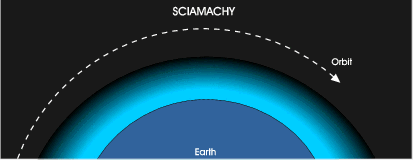Wavelength ranges
SCIAMACHY has eight spectrometer channels, which extend much farther into the infrared region than the four spectrometer channels of the GOME instrument.

Fig 1.32.3: GOME and SCIAMACHY spectrometer channels
Image: AT2-ELS
The following figure contrasts the performance of GOME and SCIAMACHY in terms of their wavelength regions and the trace gas concentrations they can measure.

Fig 1.32.4: GOME and SCIAMACHY performance comparison.
Image courtesy of :
Scanning capabilities
In nadir mode the ground pixel size for SCIAMACHY was significantly reduced to 30 x 60 km (in a special mode even to 15 x 30 km), compared with the GOME ground pixel of 40 x 320 km. This is important for the measurement of tropospheric trace gases, which can have strong spatial gradients for such species.
GOME and SCIAMACHY, principal nadir scan differences
| GOME | SCIAMACHY | |
| Ground pixels | ||
| Pixels per forward scan: | 3 | 16 |
| Pixel data | ||
| Width: Height: Scan duration: |
320 km 40 km 1.5 s |
60 km 30 km 0.25 s |
Scanning modes
Unlike GOME, SCIAMACHY can scan in both nadir mode and limb mode. SCIAMACHY's synchronised combination of nadir and limb mode scanning of the same atmospheric volumes allows it to retrieve profiles of NO2 concentrations in the stratosphere. These stratospheric profiles can be processed and then subtracted from the nadir mode measurements of NO2 concentrations in both the troposphere and the stratosphere to isolate the tropospheric concentrations. This technique is discussed in detail in the section 'Retrieval procedures' section of this module.

Fig 1.3.2.2.4.13.1: Nadir and limb matching with SCIAMACHY
This animation presents an overview of the matching of the air volumes scanned in nadir and limb modes by the SCIAMACHY instrument.